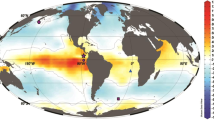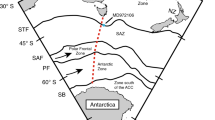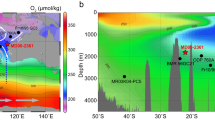Abstract
No single mechanism can account for the full amplitude of past atmospheric carbon dioxide (CO2) concentration variability over glacial–interglacial cycles1. A build-up of carbon in the deep ocean has been shown to have occurred during the Last Glacial Maximum2,3. However, the mechanisms responsible for the release of the deeply sequestered carbon to the atmosphere at deglaciation, and the relative importance of deep ocean sequestration in regulating millennial-timescale variations in atmospheric CO2 concentration before the Last Glacial Maximum, have remained unclear. Here we present sedimentary redox-sensitive trace-metal records from the Antarctic Zone of the Southern Ocean that provide a reconstruction of transient changes in deep ocean oxygenation and, by inference, respired carbon storage throughout the last glacial cycle. Our data suggest that respired carbon was removed from the abyssal Southern Ocean during the Northern Hemisphere cold phases of the deglaciation, when atmospheric CO2 concentration increased rapidly, reflecting—at least in part—a combination of dwindling iron fertilization by dust and enhanced deep ocean ventilation. Furthermore, our records show that the observed covariation between atmospheric CO2 concentration and abyssal Southern Ocean oxygenation was maintained throughout most of the past 80,000 years. This suggests that on millennial timescales deep ocean circulation and iron fertilization in the Southern Ocean played a consistent role in modifying atmospheric CO2 concentration.
This is a preview of subscription content, access via your institution
Access options
Subscribe to this journal
Receive 51 print issues and online access
$199.00 per year
only $3.90 per issue
Buy this article
- Purchase on Springer Link
- Instant access to full article PDF
Prices may be subject to local taxes which are calculated during checkout



Similar content being viewed by others
References
Brovkin, V., Ganopolski, A., Archer, D. & Munhoven, G. Glacial CO2 cycle as a succession of key physical and biogeochemical processes. Clim. Past 8, 251–264 (2012)
Sigman, D. M., Hain, M. P. & Haug, G. H. The polar ocean and glacial cycles in atmospheric CO2 concentration. Nature 466, 47–55 (2010)
Skinner, L. C., Fallon, S., Waelbroeck, C., Michel, E. & Barker, S. Ventilation of the deep Southern Ocean and deglacial CO2 rise. Science 328, 1147–1151 (2010)
Schmitt, J. et al. Carbon isotope constraints on the deglacial CO2 rise from ice cores. Science 336, 711–714 (2012)
Martínez-Botí, M. A. et al. Boron isotope evidence for oceanic carbon dioxide leakage during the last deglaciation. Nature 518, 219–222 (2015)
Martínez-García, A. et al. Iron fertilization of the Subantarctic Ocean during the last ice age. Science 343, 1347–1350 (2014)
Anderson, R. F. et al. Biological response to millennial variability of dust and nutrient supply in the Subantarctic South Atlantic Ocean. Phil. Trans. R. Soc. Lond. A 372, 20130054 (2014)
Burke, A. & Robinson, L. F. The Southern Ocean's role in carbon exchange during the last deglaciation. Science 335, 557–561 (2012)
Jaccard, S. L. et al. Two modes of change in Southern Ocean productivity over the past million years. Science 339, 1419–1423 (2013)
Galbraith, E. D. & Jaccard, S. L. Deglacial weakening of the oceanic soft tissue pump: global constraints from sedimentary nitrogen and oxygenation proxies. Quat. Sci. Rev. 109, 38–48 (2015)
Ziegler, M., Diz, P., Hall, I. R. & Zahn, R. Millennial-scale changes in atmospheric CO2 levels linked to the Southern Ocean carbon isotope gradient and dust flux. Nature Geosci. 6, 457–461 (2013)
Galbraith, E. D., Kwon, E. Y., Bianchi, D., Hain, M. P. & Sarmiento, J. L. The impact of atmospheric pCO2 on carbon isotope ratio of the atmosphere and ocean. Glob. Biogeochem. Cycles 29, 307–324 (2015)
de Lavergne, C., Palter, J. B., Galbraith, E. D., Bernardello, R. & Marinov, I. Cessation of deep convection in the open Southern Ocean under anthropogenic climate change. Nature Clim. Change 4, 278–282 (2014)
Kohfeld, K., Le Quéré, C., Harrison, S. P. & Anderson, R. F. Role of marine biology in glacial-interglacial CO2 cycles. Science 308, 74–78 (2005)
François, R. et al. Contribution of Southern Ocean surface-water stratification to low atmospheric CO2 concentrations during the last glacial period. Nature 389, 929–935 (1997)
Frank, M. et al. Similar glacial and interglacial export bioproductivity in the Atlantic sector of the Southern Ocean: multiproxy evidence and implications for glacial atmospheric CO2 . Paleoceanography 15, 642–658 (2000)
Hoogakker, B. A. A., Elderfield, H., Schmiedl, G., McCave, I. N. & Rickaby, R. E. M. Glacial–interglacial changes in bottom-water oxygen content on the Portugese margin. Nature Geosci. 8, 40–43 (2014)
Skinner, L. C., Waelbroeck, C., Scrivner, A. E. & Fallon, S. J. Radiocarbon evidence for alternating northern and southern sources of ventilation of the deep Atlantic carbon pool during the last deglaciation. Proc. Natl Acad. Sci. USA 111, 5480–5484 (2014)
Böhm, E. et al. Strong and deep Atlantic meridional overturning circulation during the last glacial cycle. Nature 517, 73–76 (2014)
Lambeck, K., Rouby, H., Purcell, A., Sun, Y. & Sambridge, M. Sea level and global ice volumes from the Last Glacial Maximum to the Holocene. Proc. Natl Acad. Sci. USA 111, 15296–15303 (2014)
Schmittner, A., Brook, E. J. & Ahn, J. in Ocean Circulation: Mechanisms and Impacts – Past and Future Changes of Meridional Overturning Vol. 173 Geophysical Monograph Series (eds Schmittner, A., Chiang, J. & Hemming, S. R. ) 392 (American Geophysical Union, 2007)
Chiang, J. C. H., Lee, S.-Y., Putnam, A. E. & Wang, X. South Pacific Split Jet, ITCZ shifts, and atmospheric north-south linkages during abrupt climate changes of the last glacial period. Earth Planet. Sci. Lett. 406, 233–246 (2014)
Boex, J. et al. Rapid thinning of the late Pleistocene Patagonian Ice Sheet followed migration of the Southern Westerlies. Sci. Rep. 3, 2118 (2013)
Herman, F. et al. Worldwide acceleration of mountain erosion under a cooling climate. Nature 504, 423–426 (2013)
Sugden, D. E., McCulloch, R. D., Bory, A. J.-M. & Hein, A. S. Influence of Patagonian glaciers on Antarctic dust deposition during the last glacial period. Nature Geosci. 2, 281–285 (2009)
Garcia, H. E. et al. Dissolved Oxygen, Apparent Oxygen Utilization, and Oxygen Saturation Vol. 3 (Government Printing Office, 2010)
Key, R. M. et al. A global ocean carbon climatology: results from Global Data Analysis Project (GLODAP). Glob. Biogeochem. Cycles 18, GB4031 (2004)
Marcott, S. A. et al. Centennial-scale changes in the global carbon cycle during the last deglaciation. Nature 514, 616–619 (2014)
Anderson, R. F. et al. Wind-driven upwelling in the Southern Ocean and the deglacial rise in atmospheric CO2 . Science 323, 1443–1448 (2009)
Taylor, S. R. & McLennan, S. M. The Continental Crust: Its Composition and Evolution. An Examination of the Geochemical Record Preserved in Sedimentary Rocks (Blackwell Scientific, 1985)
Jouzel, J. et al. Orbital and millennial Antarctic climate variability over the past 800,000 years. Science 317, 793–796 (2007)
Veres, D. et al. The Antarctic ice core chronology (AICC2012): an optimized multi-parameter and multi-site dating approach for the last 120 thousand years. Clim. Past 9, 1733–1748 (2013)
Ahn, J. & Brook, E. J. Siple Dome ice reveals two modes of millennial CO2 change during the last ice age. Nature Commun. 5, 3723 (2014)
Bereiter, B. et al. Mode change of millennial CO2 variability during the last glacial cycle associated with a bipolar marine carbon seesaw. Proc. Natl Acad. Sci. USA 109, 9755–9760 (2012)
François, R., Frank, M., Rutgers van der Loeff, M. M. & Bacon, M. P. 230Th normalization: an essential tool for interpreting sedimentary fluxes during the late Quaternary. Paleoceanography 19, PA1018 (2004)
Fleisher, M. Q. & Anderson, R. F. Assessing the collection efficiency of Ross Sea sediment traps using 230Th and 231Pa. Deep Sea Res. Part II 50, 693–712 (2003)
Henderson, G. M. & Anderson, R. F. The U-series toolbox for paleoceanography. Rev. Mineral. Geochem. 52, 493–531 (2003)
Dymond, J., Suess, E. & Lyle, M. Barium in deep-sea sediments: a geochemical proxy for paleoproductivity. Paleoceanography 7, 163–181 (1992)
Calvert, S. E. & Pedersen, T. F. Sedimentary geochemistry of manganese: implication for the environment of formation of manganiferous black shales. Econ. Geol. 91, 36–47 (1996)
Klinkhammer, G. P. & Palmer, M. R. Uranium in the oceans: where it goes and why. Geochim. Cosmochim. Acta 55, 1799–1806 (1991)
Morford, J. L. & Emerson, S. The geochemistry of redox sensitive trace metals in sediments. Geochim. Cosmochim. Acta 63, 1735–1750 (1999)
Galbraith, E. D., Gnanadesikan, A., Dunne, J. P. & Hiscock, M. R. Regional impacts of iron-light colimitation in a global biogeochemical model. Biogeosciences 7, 1043–1064 (2010)
Wagner, M. & Hendy, I. L. Trace metal evidence for a poorly ventilated glacial Southern Ocean. Clim. Past Discuss. 11, 637–670 (2015)
Yu, J. et al. Deep South Atlantic carbonate chemistry and increased interocean deep water exchange during the last deglaciation. Quat. Sci. Rev. 90, 80–89 (2014)
Lambert, F., Bigler, M., Steffensen, J. P., Hutterli, M. A. & Fischer, H. Centennial mineral dust variability in high-resolution ice core data from Dome C, Antarctica. Clim. Past 8, 609–623 (2012)
Nielsen, S. H. H., Hodell, D. A., Kamenov, G., Guilderson, T. & Perfit, M. R. Origin and significance of ice-rafted detritus in the Atlantic sector of the Southern Ocean. Geochem. Geophys. Geosyst. 8, Q12005 (2007)
Kanfoush, S. L. et al. Millennial-scale instability of the Antarctic ice sheet during the last glaciation. Science 288, 1815–1819 (2000)
Chase, Z., Anderson, R. F. & Fleisher, M. Q. Evidence from authigenic uranium for increased productivity of the glacial Subantarctic Ocean. Paleoceanography 16, 468–478 (2001)
Anderson, R. F. et al. Late-Quaternary changes in productivity of the Southern Ocean. J. Mar. Syst. 17, 497–514 (1998)
Kumar, N. et al. Increased biological productivity and export in the glacial Southern Ocean. Nature 378, 675–680 (1995)
Martínez-García, A. et al. Links between iron supply, marine productivity, sea surface temperature, and CO2 over the last 1.1 Ma. Paleoceanography 24, PA1207 (2009)
Dezileau, L., Bareille, G. & Reyss, J.-L. Enrichissement en uranium authigène dans les sediments glaciaires de l’océan Austral. C. R. Geosci. 334, 1039–1046 (2002)
Rosenthal, Y., Boyle, E. A., Labeyrie, L. D. & Oppo, D. Glacial enrichments of authigenic Cd and U in Subantarctic sediments: a climatic control on the elements’ oceanic budget? Paleoceanography 10, 395–413 (1995)
Bareille, G. et al. Glacial-interglacial changes in the accumulation rates of major biogenic components in the Southern Indian Ocean sediments. J. Mar. Syst. 17, 527–539 (1998)
Chase, Z., Anderson, R. F., Fleisher, M. Q. & Kubik, P. W. Accumulation of biogenic and lithogenic material in the Pacific sector of the Southern Ocean during the past 40,000 years. Deep Sea Res. Part II 50, 799–832 (2003)
François, R., Bacon, M. P., Altabet, M. A. & Labeyrie, L. D. Glacial/interglacial changes in sediment rain rate in the SW Indian sector of Subantarctic waters as recorded by 230Th, 231Pa, U and δ15N. Paleoceanography 8, 611–629 (1993)
Acknowledgements
S.L.J. and A.M.-G. were funded by the Swiss National Science Foundation (grants PP00P2-144811 and PZ00P2_142424, respectively), E.D.G. by NSERC, and R.F.A. by the US NSF. Sediment samples were provided by the core repository at the Lamont-Doherty Earth Observatory. Computational resources were provided to E.D.G. by Compute Canada and the Canadian Foundation for Innovation. We thank C. Buizert, H. Fischer, F. Herman and T. Pedersen for discussions.
Author information
Authors and Affiliations
Contributions
S.L.J. and R.F.A. conceived the study and S.L.J. wrote the first iteration of the manuscript. All co-authors provided input to the final version. S.L.J. oversaw the elemental analysis, while R.F.A. supervised the isotopic measurements. E.D.G. provided the climate model outputs and generated the statistical analysis. A.M.-G. refined the age model for core TN057-14PC.
Corresponding author
Ethics declarations
Competing interests
The authors declare no competing financial interests.
Extended data figures and tables
Extended Data Figure 1 Idealized model experiments illustrating the impact of AABW production on dissolved oxygen relative to the core locations.
Shaded contours show the difference in dissolved oxygen (∆O2) averaged between 25° W and 10° E, for a coupled model simulation with strong Weddell convection compared to a simulation with moderate Weddell convection (Methods). Squares indicate the location of sediment cores TN057-13PC and TN057-14PC.
Extended Data Figure 2 Biogenic particle flux reconstructed by 230Th normalization for four independent proxies covering the last glacial termination at site TN057-13PC.
a, 230Th-normalized total organic carbon flux43. b, 230Th-normalized CaCO3 flux. c, 230Th-normalized biogenic barium (bioBa) flux. d, 230Th-normalized biogenic opal flux29. CaCO3 and bioBa data are from this study. The accumulation of biogenic CaCO3 above glacial background values during HS1 and the YD is consistent with enhanced ventilation of bottom waters during these intervals. Enhanced ventilation of bottom waters would have lowered the regenerated DIC concentration of the bottom water by releasing excess CO2 to the atmosphere, raising the [CO32−] (ref. 44) and calcite saturation state of the bottom water9 and thus reducing CaCO3 dissolution.
Extended Data Figure 3 Qualitative changes in oxygenation between the LGM and the Holocene.
Red/black dots indicate the location of sedimentary records for which authigenic U concentrations/mass accumulation rates were higher/lower during the LGM when compared to the Holocene, respectively. White dots highlight cores where authigenic U concentrations did not change much between these two intervals (see Extended Data Table 1 for details). Shadings show the modern bottom water dissolved oxygen concentrations26.
Extended Data Figure 5 Comparison of bulk sediment accumulation rates and authigenic U concentrations in sediment core TN057-14PC for the interval 20–80 kyr ago.
a, Bulk sediment accumulation rates (SedRate). b, Authigenic U concentrations.
Extended Data Figure 6 Comparison of the deglacial sequences at sites TN57-14PC and TN057-13PC.
a, δ18Opachy (where ‘pachy’ refers to the planktonic foraminifera Neogloboquadrina pachyderma) (ref. 46) and 230Th-normalized biogenic opal flux28 in core TN057-14PC. b, δ18Opachy (ref. 47) and 230Th-normalized biogenic opal flux28 in core TN057-13PC. The grey shading highlights the disturbed portion of core TN057-14PC. The black triangle highlights the presence of planktonic foraminifera deposited during the Younger Dryas (that is, 12.18 kyr ago; ref. 46), which have been mixed down into late LGM sediments after the hiatus occurred.
Source data
Rights and permissions
About this article
Cite this article
Jaccard, S., Galbraith, E., Martínez-García, A. et al. Covariation of deep Southern Ocean oxygenation and atmospheric CO2 through the last ice age. Nature 530, 207–210 (2016). https://doi.org/10.1038/nature16514
Received:
Accepted:
Published:
Issue Date:
DOI: https://doi.org/10.1038/nature16514
This article is cited by
-
Indian Ocean glacial deoxygenation and respired carbon accumulation during mid-late Quaternary ice ages
Nature Communications (2023)
-
Southern Ocean glacial conditions and their influence on deglacial events
Nature Reviews Earth & Environment (2023)
-
Millennial atmospheric CO2 changes linked to ocean ventilation modes over past 150,000 years
Nature Geoscience (2023)
-
Multiple carbon cycle mechanisms associated with the glaciation of Marine Isotope Stage 4
Nature Communications (2022)
-
Enhanced ocean oxygenation during Cenozoic warm periods
Nature (2022)
Comments
By submitting a comment you agree to abide by our Terms and Community Guidelines. If you find something abusive or that does not comply with our terms or guidelines please flag it as inappropriate.




 (ref.
(ref.